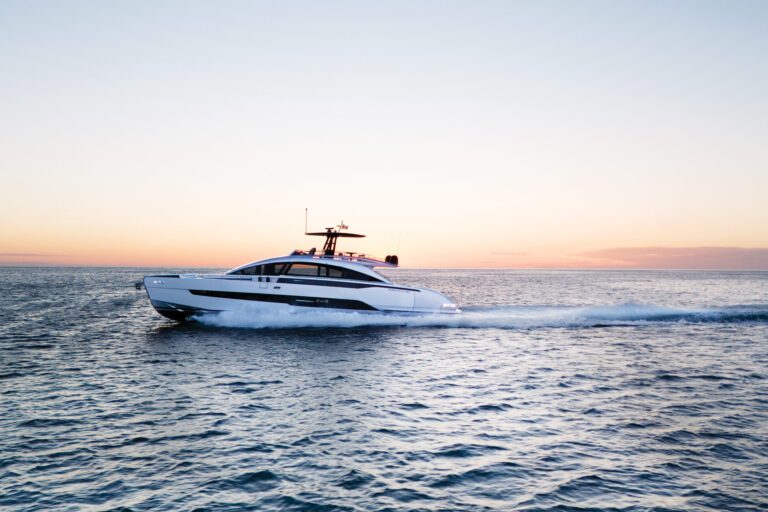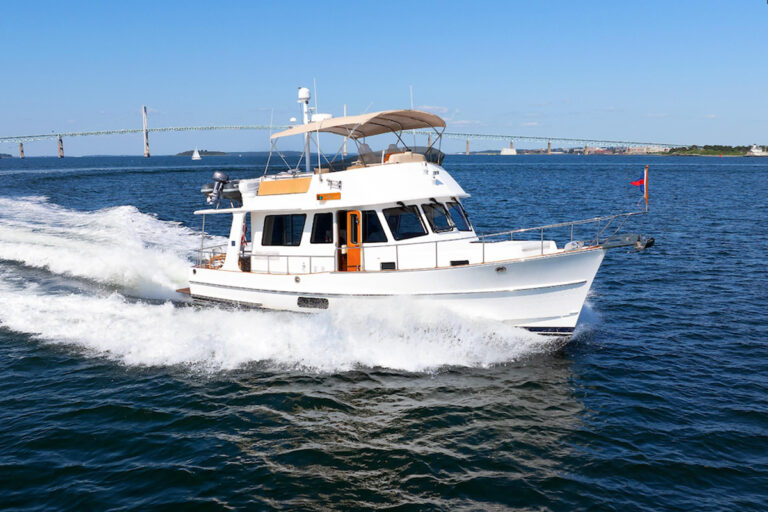The adage about good things coming in small packages just got truer with Garmin’s GPSmap 198C Sounder, which provides a full capability chart plotter/dual-frequency fishfinder as well as a very useful adjunct to a yacht’s digital selective calling (DSC) VHF radio transceiver. Unlike most chart plotters, where the charts must be purchased at additional cost, the 198C comes complete with both a worldwide base map and Garmin’s BlueChart cartography for the United States, along with those adjacent Canadian waters that are depicted on U.S. charts. Controlled via 10 clearly marked keys plus a four-way cursor, the 198C’s well-designed operating system made it easy to use even before investigating the 100-plus-page owner’s manual. Housed in a waterproof enclosure slightly more than 6 inches square and less than 3 inches deep, the unit’s sunlight readable, 234 x 310 pixel, 16-color TFT LCD screen was clearly visible, even when viewed through polarized sunglasses during an on-water evaluation.
The system’s external antenna-housed GPS receiver uses all visible GPS satellites and, in addition, employs information from Wide Area Augmentation System (WAAS) satellites. The WAAS is a form of differential GPS provided by the FAA to improve the position accuracy and integrity of the GPS system for aviation use. The WAAS satellites carry identification numbers of 33 or higher and are positioned in geostationary orbits over the equator. The 198C will indicate that it is using the WAAS signals to enhance GPS position information by adding a “D to the signal bar in the sky view GPS status window and by adding “Differential to the receiver status display in other data windows. If desired, a separate low-frequency Coast Guard differential correction receiver can be connected to provide the conventional maritime DGPS functions.
In addition to all of the navigation, chart plotter, sonar and information reference features expected in a unit of this type, the 198C provides a communications interface with the yacht’s VHF/DSC radio. As with most chart plotters, GPS data from the 198C can provide a yacht’s radio with the vessel position information it must have in order to function properly when making DSC-initiated distress calls; this information is also a valuable asset for all routine calls, of course.
The additional capability of this unit becomes evident when the radio receives a DSC-initiated call. The digital information contained in the Channel 70 hailing call is transferred to, and automatically stored in, the plotter’s DSC call list and log. The logged data includes the type of call (distress, routine or position report), the calling vessel’s Maritime Mobile Service Identity (MMSI) number, the name of the vessel if previously stored in the 198C, the date and time of the call, the calling vessel’s latitude and longitude, and the distance and bearing to the calling vessel from your position. Immediately available options include establishing a waypoint at the caller’s position and/or a Show Map choice that instantly opens a chart view of the situation. Distress call log entries are retained until specifically erased, while routine entries are more readily discarded.
This system makes navigation to the location of a distress or routine call virtually automatic. Press the NAV key, use the cursor to highlight the MMSI/Name of the calling vessel and press the ENTER key. The unit will display the bearing and distance to the calling vessel’s position. The yacht’s autopilot will do the rest. Although the radio interface system will be of greatest value when a distress call is received, the system will be appreciated most frequently when sailing in company with other vessels or when rendezvousing with a friend’s yacht. The introduction of the Coast Guard’s Rescue 21 system, planned to begin this year, will greatly expand the use of DSC hailing, making this communications interface an increasingly valuable asset.
The amount of memory that is now practical in a unit that sells for the $1,179 list price of the 198C is evident from the extent of the data available from the unit’s memory. The cartography library is comprised of a worldwide base map viewable with scales from 800 to 8 nautical miles per centimeter on the LCD. The Garmin BlueChart cartography for marine navigation is viewable with scales between 8 nautical miles per centimeter and 800 feet per centimeter. At the 800-foot/centimeter scale, the chart view on the LCD shows an area 2 miles in height and 1.5 miles wide. The BlueChart cartography includes all the U.S. chart information, including extensive areas along the Canadian coastline, the Great Lakes, Hawaii and offshore areas, such as Puerto Rico and the U.S. Virgin Islands. The cartography database contains an extensive library of supporting information. Tide height data for any 24-hour period for stations within 100 miles of the yacht’s position is obtained via the menu’s Tide tab-specific stations can then be chosen from the pop-up menu. A total of some 3,000 reporting stations can be accessed. A wide variety of other information is available by selecting one of the numerous headings shown under the Information tab. Within the limits imposed by the size of the LCD screen, the unit provides a very useful navigation tool for any vessel.
The plotter’s user data storage capacity accommodates up to 3,000 waypoints, each identified with up to 10 characters, a selectable symbol, a depth notation and up to 20 characters for comments. Up to 50 routes, each comprised of as many as 254 waypoints, can be stored. In addition, the Garmin TracBack function will automatically preserve a track-log containing up to 254 turns, providing an immediately accessible and very valuable capability when retracing the course followed into an uncharted anchorage. Creating, moving and using waypoints are point-and-shoot processes. Position the pointer, press the ENTER key and use the new map waypoint window to enter the details that will identify the waypoint. Pressing the ENTER key stores the data in memory. The process for creating routes and for editing waypoints and routes is equally straightforward and is more easily done than it appears from reading the owner’s manual.
The system is managed via an easily accessed 18-item program menu. Many of the program entries are used for initial setup and need not be accessed during routine use of the system. Access to the detailed content of each menu is direct, logical and will be readily understood by anyone who uses a computer.
The POWER key is about the only aspect of the design that deserves a second look. Unlike many similar products where prolonged pressure on the POWER key is required to turn the unit off, a momentary, even accidental push on the key will immediately shut off the 198C.
The Garmin 198C provides all of the functions of an advanced chart plotter, in a compact, easy-to-install, easy-to-use unit.
Contact: Garmin, (888) 442-7646; www.garmin.com.





